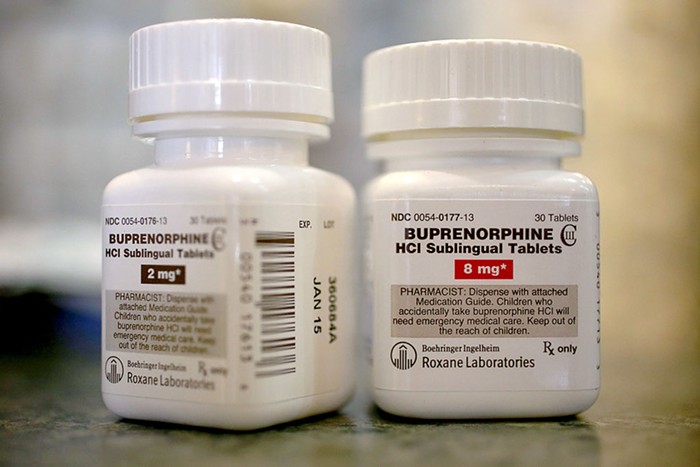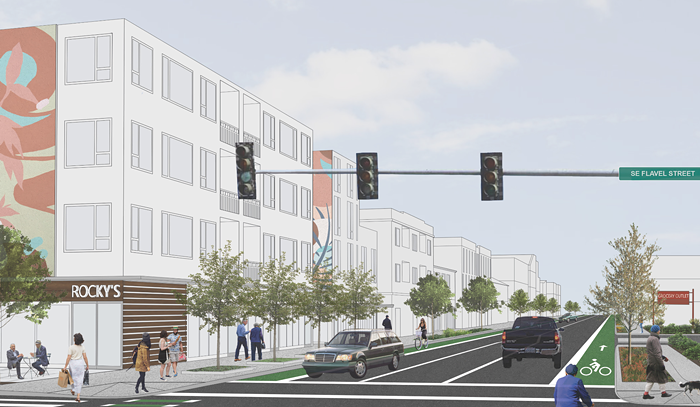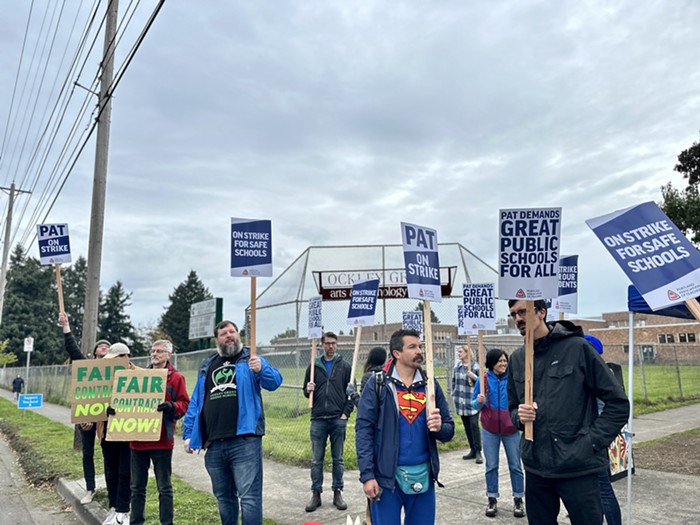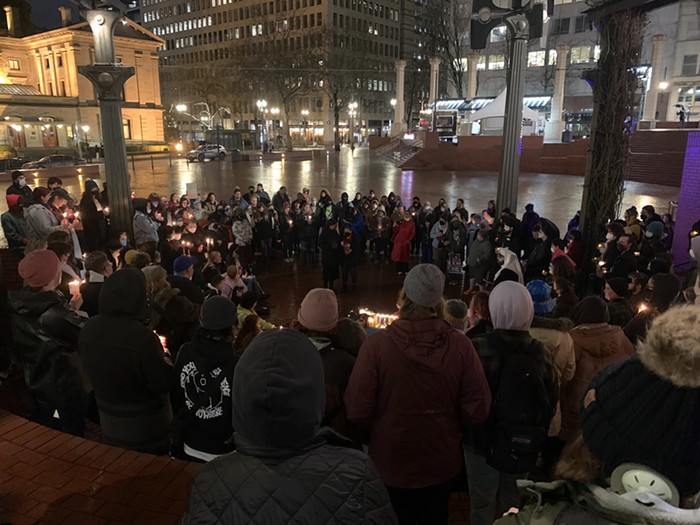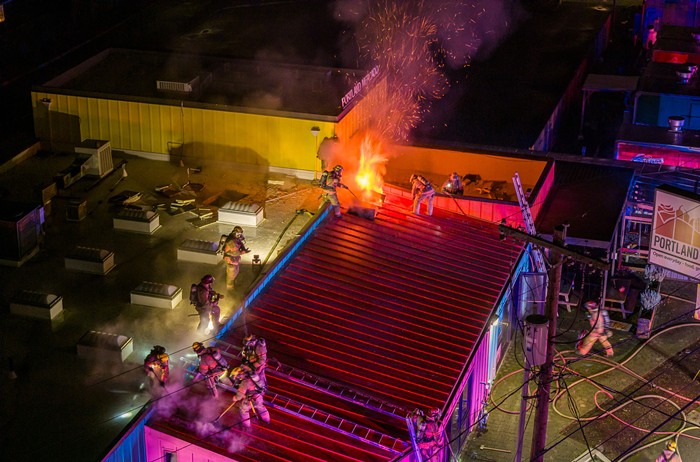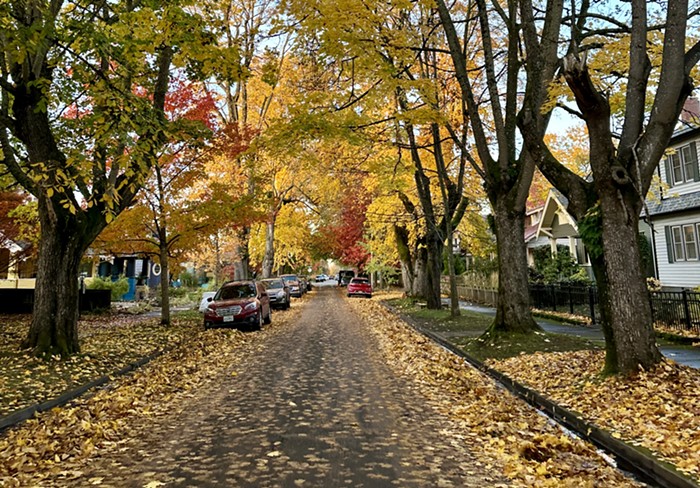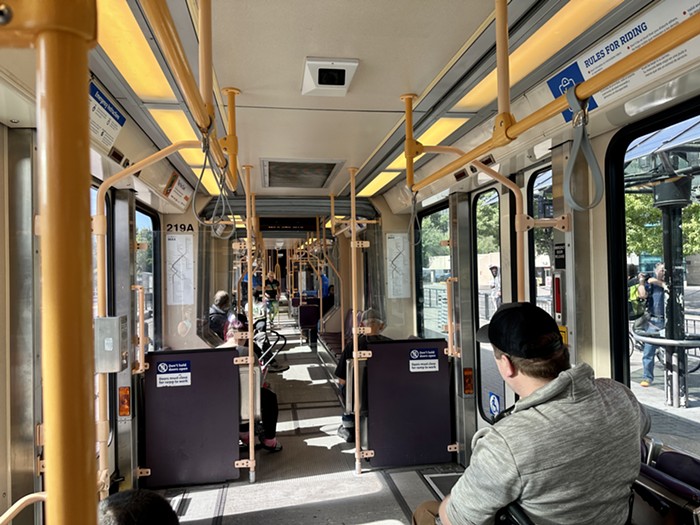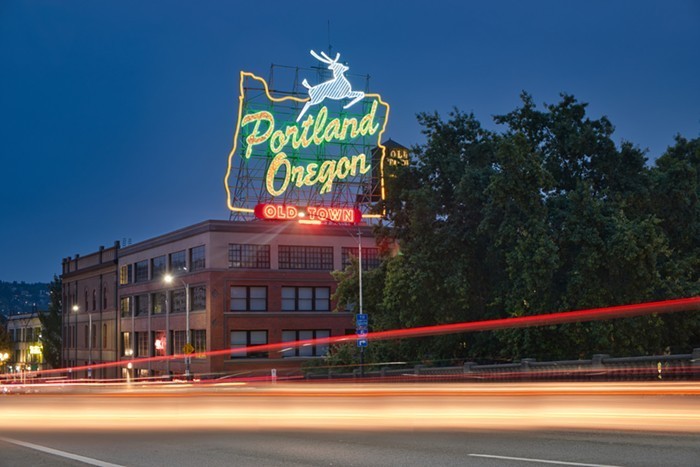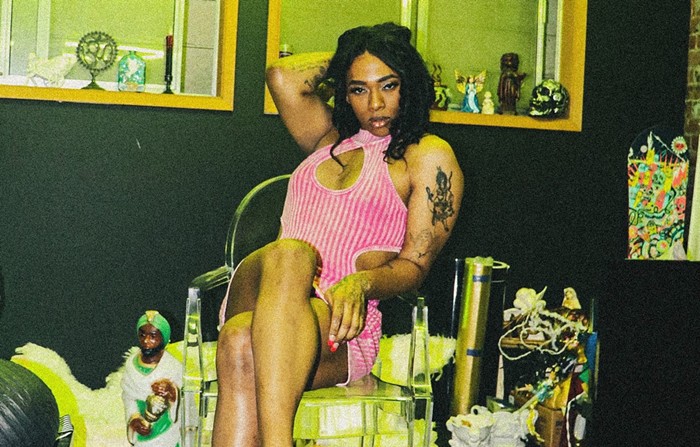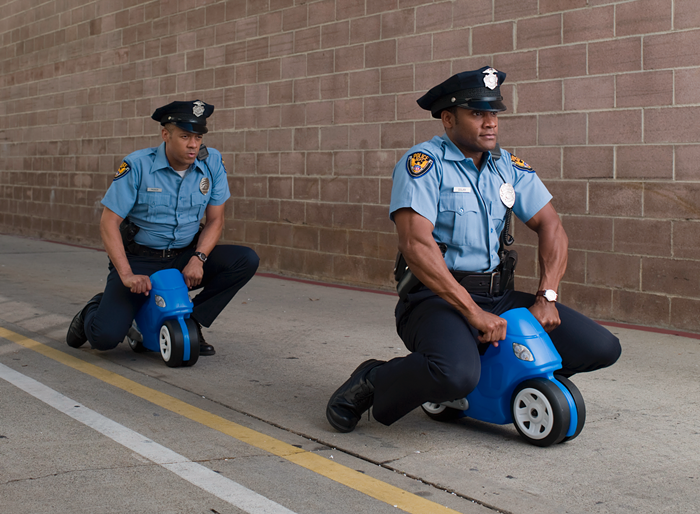
Holly Akimesu-Leitgeb first found out about a COVID-19 vaccine clinic prioritizing Pacific Islander elders through her hula group. She jumped at the chance to sign up her father, Terry Kalei Akimesu, 69, for the Feb. 27 drive-thru clinic, hosted by the Oregon Pacific Islander Coalition through Multnomah County.
Rather than waiting in a large convention center full of strangers, Akimesu-Leitgeb and her father drove through the vaccine clinic in a matter of minutes. The clinic was held outside a Latter Day Saints church in Southeast Portland, where Pacific Islanders already gather for weekly volleyball matches.
For Akimesu-Leitgeb and her father, the vaccine clinic acted as a reunion with the close-knit Native Hawaiian and Pacific Islander community. They were greeted throughout the drive-thru by friends they hadn’t seen in over a year. And unlike one of Oregon’s standard mass vaccination events, interpreters of various Pacific Islander languages were on site.
“Being able to attend vaccine clinics with organizations you're already familiar with helps our people get access and also lays their fears to rest about the vaccine itself,” said Manumalo “Malo” Ala’ilima, who is the co-chair of United Territories of Pacific Islanders Alliance Portland (Utopia PDX for short), one of the organizations that makes up the Oregon Pacific Islander Coalition.
The coalition directly invited elders over 70—the state’s eligibility requirement at the time—to sign up through community organizations, like Akimesu-Leitgeb’s hula group, and they were ultimately able to give 423 vaccines to seniors in their community, along with seniors from other Black, Indigenous and People of Color (BIPOC) communities.
When it comes to vaccinating communities of color in Oregon, however, Ala’ilima said targeted clinics like these are a start, but they are not enough. Native Hawaiians and Pacific Islanders have the highest rate of infection by COVID than any other race in Oregon.
According to a March 3 report by the Oregon Health Authority (OHA), Pacific Islanders statewide have a case rate of about 840 per 10,000 Pacific Islanders living in Oregon. This estimate is about four times greater than the rate for white Oregonians, which comes in at 212 cases per 10,000 white people living in the state.
Since last July, Ala’ilima—who is of Samoan and Tongan descent—saw five family members pass away after contracting the virus. They all lived in California, where Pacific Islanders are also disproportionately affected by the virus. Ala’ilima said Utopia PDX, and other coalition members, are working tirelessly to provide vaccines and other COVID resources to prevent more loss and grief in their communities.
"We're not able to prioritize services or make decisions solely on somebody's race or ethnicity."
Pacific Islanders, along with other BIPOC populations, have been disproportionately impacted from the underlying health conditions, like heart disease or diabetes, that make people more vulnerable to the severe impacts of COVID. These communities of color also often live in multigenerational households or face socioeconomic barriers that prevent access to health insurance, making them all the more vulnerable to the virus.
Oregon attempted to address these kinds of health inequities in its vaccine distribution ahead of time by assembling a COVID Vaccine Advisory Committee, composed of Oregonians from communities at higher risk of contracting and dying from COVID-19. The committee was created to advise OHA on its vaccine sequencing plans and ensure the communities most affected by COVID are included. The group initially voted to recommend including communities of color as one of the groups to be prioritized in the state’s vaccine rollout after people that are 65 and older. But, OHA struck this down for legality reasons, citing a clause in the 14th Amendment which prohibits states from denying any person equal protection of the laws.
"We're not able to prioritize services or make decisions solely on somebody's race or ethnicity," said Rachel Banks, director of Oregon's Public Health Division, during a meeting with the committee on Jan. 28.
The committee ended up recommending the prioritization of adults ages 16 to 64 with underlying health conditions, front-line workers, people in custody, people living in low-income and congregate senior housing and multi-generational households. These recommendations were largely reflected in Governor Kate Brown’s guidelines for prioritization, which were released in February. There is no mention of race in the guidelines.

The committee noted that communities of color do fall into many of these categories, meaning they would still get early access to the vaccine, but also acknowledged in a memo that they were limited by “structural racism and systems that are not ready to center this truth about the ways structural racism impacts the health of Black, Indigenous and People of Color (BIPOC) communities.”
Kelly Gonzales, an OHSU-PSU public health professor that represented urban natives on the committee, said she was feeling “grief” after not being able to explicitly prioritize communities of color, even though the data shows these groups are disproportionately affected by the virus.
“I felt that we had this opportunity to model equity, that was not real equity,” she said. “What I realized in that work was that even the laws aren't set up to support equity outside of the constraints or the confines of the status quo.”
Despite potential legal challenges, other states did more to specifically prioritize communities of color. Montana, for instance, prioritized “American Indians and other people of color at elevated risk for Covid-19 complications” in one of its earliest eligibility groups for the vaccine.
Gonzales said that although Oregon was unable to specifically prioritize BIPOC, assembling the Vaccine Advisory Committee and acknowledging these shortcomings was still a step towards building a more equitable state health system.
Yet Oregon’s vaccine rollout has been far from equitable thus far. For example, the Latinx population currently accounts for 4 percent of total persons vaccinated in the state, while they make up 13 percent of the population and about 34 percent of all COVID cases statewide.
“I felt that we had this opportunity to model equity, that was not real equity.”
Portland City Commissioner Carmen Rubio is familiar with these equity gaps from her previous role as the director of the Latino Network. Asked about the vaccine’s inequitable distribution among Latinx populations, Rubio told the Mercury in an email, “Some might say that this is because Latinx Oregonians are hesitant but that’s just not true: Latinx organizations are ready and capable, and community members are willing.”
“Everyone wants to know that they are valued by their government: we need a statewide vaccination strategy that demonstrates that to communities of color,” Rubio continued. “(Multnomah) County’s commitment to a BIPOC vaccination strategy has impressed me, but I’ve also been disappointed that the state has not made a similar commitment.”
OHA’s strategy for getting vaccines to communities of color largely revolves around federally-qualified health centers that have ties with their communities, along with targeted vaccine clinics on the county and local level, like the one hosted by Multnomah County and the Oregon Pacific Islander Coalition.
“I think we're at the table now,” said Ala’ilima. The Oregon Pacific Islander Coalition, along with other community organizations, has been in conversation with Multnomah County, Kaiser Permanente and OHA during the vaccine distribution process.
Multnomah County has partnered with community organizations to target different BIPOC groups. Since Feb. 19, the county has vaccinated roughly 2,400 people through clinics prioritizing these communities, and these numbers continue to grow. They aim to prioritize vaccinating BIPOC residents, but white people that are eligible for the vaccine are not turned away.
The county has long recognized the need to end health disparities for communities of color. In 2014, they received a Centers for Disease Control and Prevention (CDC) grant for its Racial and Ethnic Approaches to Community Health (REACH) program, which specifically addresses health disparities within African-American communities.
According to Charlene McGee, the REACH program manager, the county’s efforts to distribute the vaccine “continue to be equity and data driven.” This means prioritizing BIPOC populations, who are most affected by the virus largely because they are in communities historically underserved in healthcare.
The county is bringing the vaccine to spaces where communities already trust, like churches, rather than requiring people to go to mass vaccination sites, like the one at the Oregon Convention Center where thousands of people are vaccinated a day.

“A large majority of folks are saying, ‘I don't want to go to a mass vaccination clinic because the people don't look like me, they don't speak the language and how are they supposed to help me,’” said Jazmine Bowles, Multnomah County’s nursing supervisor for the COVID response team.
Bowles and McGee said that vaccine hesitancy, stemming from a history of medical abuse and inequities for communities of color, is part of the problem, but not all of the problem. They said BIPOC Oregonians are being under-vaccinated largely due to accessibility issues related to the internet, language, and transportation—and that’s why it’s important to bring clinics to community sites.
The county held one of its first BIPOC-focused clinics on Feb. 19 at Highland Christian Center, where 450 eligible community members got their first shot. The church’s outreach program, Highland Haven, is a part of Multnomah County’s Action Communities for Health, Innovation and Environmental Change (ACHIEVE) Coalition, a multi-sectoral group focused on ending health inequities for African Americans and African immigrants/refugees.
As one of the state’s largest African American churches, Highland Christian Center is a “hub for the community,” said Shon Neyland, a senior pastor at the church.
“The church directly counters the lack of trust that African Americans traditionally have in the medical system,” he said
Thus far, only 1 percent of those vaccinated in Oregon are Black, while this group makes up over 2 percent of the state’s population and nearly 2.5 percent of the state’s COVID cases. According to OHA data, Black Oregonians are also three times more likely than non-Hispanic white people to be hospitalized with the disease.
"A large majority of folks are saying, ‘I don't want to go to a mass vaccination clinic because the people don't look like me, they don't speak the language and how are they supposed to help me.'"
Asian people account for 4 percent of vaccinations in Oregon and 4.9 percent of the population, while American Indian and Alaska Natives account for 2 percent of vaccinations and 1.8 percent of the population.
“We are in a serious state of emergency right now, and what we need to do is open up the church doors for vaccine clinics,” said Teresa Johnson, health and wellness team leader at Highland Haven.
Currently, about 80 percent of vaccines go to mass vaccination clinics. Johnson thinks the state should give more allocations to counties and community sites and then give the rest to mass clinics. She also agrees with critics that say that the state should have prioritized BIPOC communities in the next distribution phase.
“This would have been a great opportunity to show that everybody is important and that if we see the numbers saying that your population is the one who is in danger right now, then that's where we're going to go, and then let's work our way up,” Johnson said. “But we didn't, and it just made people feel more uneasy about the whole rollout of the vaccine.”
In order to address any unease about the vaccine, community organizations across Oregon have been holding virtual information sessions. Both the Latino Network and Virginia Garcia Memorial Health Center have been hosting many of these events in Spanish.
Veronica Leonard, the director of health and wellness at the Latino Network, said she had expected to address vaccine hesitancy in these information sessions, but she found that people were more concerned about not being able to access the vaccine.
“A lot of our community is ready, and their arms are sticking out ready for the vaccine to be put in, and they're really concerned that they're not able to access it,” Leonard said.
The demand is evident in how quickly vaccines disappear during distribution events. When one of Multnomah County’s BIPOC-specific clinics was held at Rockwood Boys & Girls Club, which is next door to the Latino Network’s office, Leonard said that appointment spots filled up before the organization could sign any of their members up.
For weeks, Latino Network staff has been helping community members navigate the state’s complicated online registration system. The state didn’t have a Spanish language option on its vaccine registration website until March 4 and still doesn’t offer any other languages.
“Language accessibility can't be an afterthought, or a ‘we'll get it soon’ but rather needs to be rolled out at the same time as all English tools,” Leonard said via email.

The state says the primary way it will target communities of color is through federally-qualified health centers such as Virginia Garcia Memorial Health Center, which operates throughout Washington and Yamhill counties and has close ties with Oregon’s Latinx populations.
The health center currently gets 1,100 doses a week from the state, but it is on track to get at least 2,500 more prime doses a week as a part of the federal government’s program to ensure vaccine equity. Virginia Garcia was one of four Oregon health centers to qualify for this program, and starting this week, it is gearing up to vaccinate 30,000 people in 12 weeks, according to the center’s executive director Serena Cruz.
This will account for nearly 5 percent of the entire populations of Yamhill and Washington counties. Vaccine events at community sites in Washington County are also ramping up—on March 7, the county hosted a clinic at the Muslim Educational Trust, with help from New Portland Foundation, Multnomah County and OHA.
“There is an equity crisis, and the state has started to respond,” Cruz said. “In addition to this initiative to work with federally qualified health centers, being more flexible in their approach about prioritization guidelines will make a big difference.”
Virginia Garcia has been advocating for more flexibility in who they can vaccinate, since they are running out of patients in the age groups currently eligible for a COVID vaccine. Cruz said these age restrictions are a major reason communities of color are being vaccinated at low rates, citing a 2019 Pew Research study that found the most common age among white people in the U.S. is 58, while the most common age is 11 for Latinx people, 27 for Black people and 29 for Asian people.
“We know that age restrictions [for vaccines] are inherently components of structural racism,” Cruz said.
Her concerns were heard at the state level. As of March 5, the state granted federally-qualified health centers, such as Virginia Garcia, flexibility to vaccinate all of their patients, regardless of age.
“OHA recognized that our patients are particularly diverse and vulnerable and see this program as a way for the state to better meet the needs of communities that are disproportionately affected by the pandemic,” Cruz said via email. “OHA did ask that our vaccination work prioritize Oregon’s eligibility phases as we begin to reach more deeply into our patient population.”
With the newly-approved Johnson & Johnson vaccine, Oregon is expecting a boost in vaccine allocations, which could increase the number of doses going to federally-qualified health centers, counties and other groups working to get shots to communities of color.
“There's a multi-layered strategy in place,” Cruz said. “We're reaching out, and the counties and their partners are reaching out. I think that we will collectively be able to get to vaccinate a much more diverse community.”
